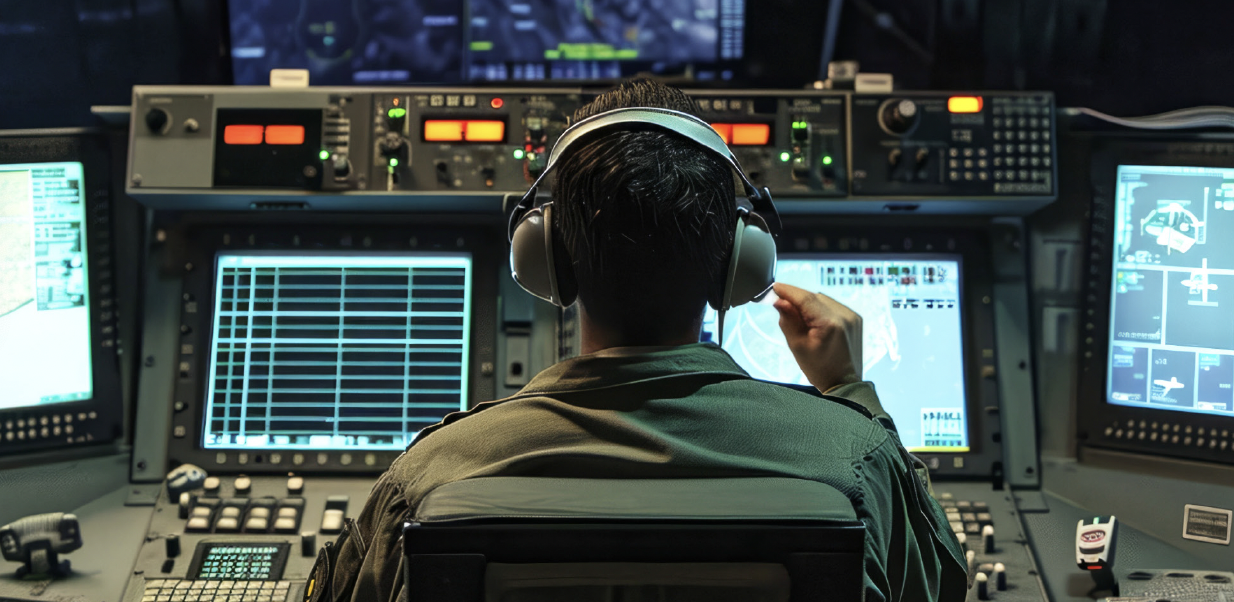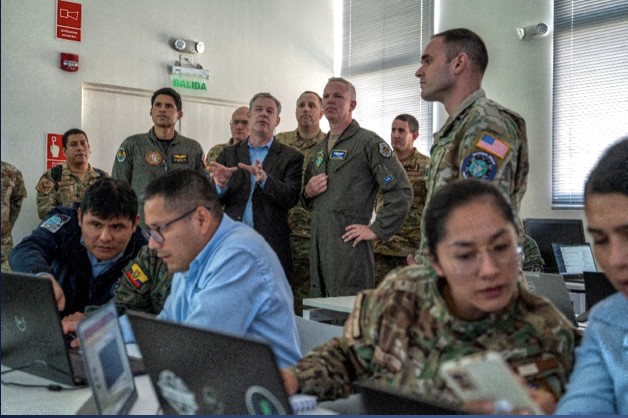Joint all domain operations demands the ability to make critical decisions at speed based on accurate and timely data.

The U.S. Space Force has a wealth of space-based data that goes back as far as the earliest days of space exploration, with new, critical information gathered every second. However,t data isn’t helpful if it’s siloed, can’t be interpreted quickly, or shared with other military services and allies.
That’s why Space Systems Command (SSC) is working to make that data more accessible, at the speed of relevance and over resilient systems that can withstand attack from adversaries.
The Unified Data Library (UDL) is the Cloud-based data repository that hosts a wide range of data, including data for space domain awareness (SDA).

Lt. Col. Dan Kimmich
The UDL contains more than 300 different data types in addition to commercially acquired data, enabling the Space Force, government and allied partners access to a multitude of data sources from a centralized repository.
“The UDL empowers us to harness the power of data, from more sources, in less time, enabling users to collaborate and analyze data in different ways,” said Lt. Col. Dan Kimmich, Materiel Leader, Cross Mission Data at SSC. “This leads to better, faster decision making and for multi-domain operations, it helps create a more complete picture of any exercise or battlespace.”
The UDL is one of the many data solutions that improve accessibility, management, and use of data offered by the Cross Mission Data branch, under the Battle Management Command, Control and Communications (BMC3) program executive office at SSC.
Cross Mission Data’s mission is to provide data as a strategic asset to the Space Force, Department of Defense (DoD), and allies to enable command and control at the speed of battle.
“The UDL is just one of the many ways SSC is leveraging cutting-edge technology to deliver speed to the joint all- domain fight,” said SSC’s Shannon Pallone, program executive offer for BMC3, a $4 billion portfolio of more than 13 programs and 31 sub-applications / projects encompassing a wide- range of mission areas, including enterprise ground services, information mobility, command and control, cross mission data, and data transport.

“Space-based assets and the C3 systems that provide access to these assets enable us to detect threats, deter aggression, and protect our way of life,” Pallone said. “The faster we can process this information, compare it with data from our allies, and deliver it to our warfighters when they need it, the stronger our nation will be.”
The UDL includes vast amounts of space data, ranging from launch notifications, track and positional data, conjunction assessments (when two residents space objects pass within a certain number of kilometers of each other), maneuvering messages, and the catalog of space objects collected by the 18th Space Defense Squadron.
In fact, the Space Force has every metric observation (the distance between two objects in space) since the 1950s.
“Prior to 2019, components that now make up the Space Force were spread out across the U.S. Department of Defense, and the focus was on catalog maintenance – maintaining an accurate list of space objects – everything from space debris to space vehicles and celestial bodies. However, this is rapidly expanding with the escalating amount of space activity as well as adversarial threats in this domain making Space Domain Awareness take on a new urgency,” Kimmich said.
“If we send a Space Domain Awareness sensor to look at a particular object and we don’t discover that object, but something in close proximity to that, we continue to track that object and work to identify what it is, because the object may have maneuvered or there may be a secondary object now in the frame,” Kimmich said.
“Collecting all of this information enhances the ability to tip and cue sensor networks around the globe and alert leaders that we’ve now seen something we didn’t expect,” Kimmich continued. “This awareness accelerates our ability to close kill chains and get critical information where it needs to go, from an operational level but also the tactical level so decision makers are able to take action quickly.”
The UDL itself was launched only as recently as 2018, as a pilot project by the Air Force Research Library, and SSC’s Air Force predecessor organization. It was mainly seen as a platform to control data the Space Force purchased from commercial vendors, and make sure only those who had a need to access that data could do so.
However, it soon demonstrated utility beyond this initial purpose, demonstrating the importance how properly curated data also results in information that can be trusted and implemented quickly to support operations.
One of the UDL’s earliest examples was in aiding Operation Allies Refuge, the evacuation from Afghanistan effort in 2021, led by Air Mobility Command under the U.S. Air Force.
Multiple data sets related to aircraft, mission status, mobility, logistics, personnel, and supply-chain data from a wide range of sources across the DoD and other government agencies were rated into the UDL.

Warp Core, an SSC platform that provides data analytics and visualization tools, ingested, consolidated, curated, and fused the data provided from the UDL, with data collected from other sources across the government to deliver an authoritative picture of events in a dynamically changing environment.
“Everyone who was connected to the UDL started receiving that information as soon as it was published,” Kimmich said. “The Secretary of Defense, Air Mobility Command, the FBI, Homeland Security. Because we broke down data silos across all of these different organizations, we were able to expose to a variety of different agencies and consumers. When you break down silos, you get away from all these single points of integration but also the aggregate data received from these silos together forms a whole far greater than sum of its parts.”
During Operation Allies Welcome, the UDL again helped correlate passenger records for the relocation, in-processing, and resettlement of Afghan refugees in the United States.
More recently, during last summer’s Operation Resolute Sentinel (RS) 23, a U.S. Southern Command (SOUTHCOM) global exercise, held in Lima, Peru, the UDL team augmented the Joint Commercial Operations (JCO) cell to support the Surveillance, Reconnaissance, Tracking (SRT) Initiative.
Resolute Sentinel is a SOUTHCOM exercise that provides joint training and improved readiness of U.S. and partner nations. The JCO is a U.S. Space Force led initiative that uses commercial providers to deliver diverse, timely SDA capabilities to the U.S. and allies.
“The UDL serves as the foundation for exposing data to our JCO and is an incredible opportunity for us to build our operational concept of how we would fight in alliance with our allies,” said Kimmich.
During this exercise, the JCO team was able to leverage commercial data accessed from the UDL’s Global Data Marketplace to identify and geo-locate a vessel suspected of illegally fishing in Peruvian waters, as well as imaging a volcano that showed signs of an impending eruption in Columbia. This event further demonstrated how UDL capabilities can be used in worldwide joint operations.

Peruvian Coast Guard members prepare for training with the U.S.
Coast Guard Maritime Safety and Security Team (MSST) 91101
(Seattle), at Base Naval del Callao, Peru, July 4, 2023 during
exercise Resolute Sentinel 23. Resolute Sentinel improves
readiness of U.S. and partner nation military and interagency
personnel through joint defense interoperability training,
engineering projects and knowledge exchanges.
Several portions of the UDL have been operationally accepted — which is achieved when the operations community has formally accepted a capability from the acquisition community to execute their mission.
“We’ve taken it through a prototyping phase and we’re now entering the software acquisition pathway to make it a reportable program through SAF SQ (Secretary of the Air Force for Space Acquisition and Integration,)” Kimmich said. “We’re working with the operational community to build the capability needs statement, which will reflect what our squadrons and deltas will need from the ULD to serve them as an operational system.”
In the meantime, upgrades continue to be made to the system, further enhancing it, and increasing its effectiveness and its resiliency. This includes providing iterations of the system to operate in a disrupted, disconnected, and intermittent and low- bandwidth environment during times of conflict, Kimmich said
To be able to operate under these conditions, the Cross Mission Data team created the Tactical UDL, a 45-pound instance of the Enterprise UDL that can be connected to the operational system of an aircraft allowing warfighters to access and manipulate critical mission data in real time.
“Speed, location, fuel, armament all passes through that data bus, but warfighters able to tailor what information they want to store locally so in the event they’re not able to sync with the UDL on CONUS (Continental United States) if they’re forced to not broadcast for security purposes, that information is stored on board,” Kimmich said.
“It could be flight plans, it could be mission operations – it’s connected to their on-board satellite communications, and if that is not available, the system can also access 5G, and then we can add another antenna to access Starlink and eventually Starshield communications from the Department of Defense, when it’s accessible.”
“We have visions of establishing these mini UDLs next to our ground-based SDA sensors so that if our sensors themselves get disconnected, they’ve got an on-board catalog they can use to continue tracking objects, continue publishing that information to the onboard UDL, and then, when it’s resynchronized, directly share that back to the enterprise UDL and make it available,” Kimmich said.

Resolute Sentinel 23 Combined Joint Task Force senior leaders
conduct a tour at the Centro Nacional de Operaciones de Imágenes
Satelitales, Peru, July 4, 2023. The space exercise, led by U.S.
Southern Command in partnership with U.S. Space Command’s Joint
Task Force Space Defense Commercial Operations (JCO) Cell, the
Peruvian Aerospace Research and Development Center (CONIDA),
and the Peruvian Air Force, aims to bolster the region’s emerging
space program.
To further expand data solutions on a global scale, Cross Mission data is working on incorporating artificial intelligence (AI) and machine learning (ML) with data in the UDL to increase the speed of decision-making and facilitate data sharing with allies through the Allied eXchange Environment (AXE).
The AXE, which won SSC’s second annual “Fight Tonight” innovation competition in November of 2023, is a standardized interface that facilitates secret-level data sharing with international partners. Data provides the foundation to enabling AI/ML, providing a secure repository of data. Therefore, holding an endless supply of data from a multitude trusted sources from around the globe creates limitless possibilities for AI/ML to be used for national security purposes.
“There hasn’t been a means by which we can machine- to-machine share data with our allies,” Kimmich said. “We have systems that enable email exchanges, we have systems that enable calls, but we’ve never gotten to the point where in real time – seconds to minutes, not hours-we’re able to share data between nations.”
“AXE is attempting to do that – basically be a landing point for data coming in from our allies – it will sync with our U.S. database and allow that information to flow seamlessly machine to machine, based on how it’s classified, and will get us to a point where we can in real time share that information which is critical to how we intend to fight in space, going forward,” Kimmich said, adding, “As our adversaries continue to advance their space and anti-satellite capabilities, we need to rely on data collected from sensors across the globe from our allies to make sure we’re detecting and maintaining custody of these space objects.”
“This is done completely at the unclassified level, but with the sensors that are provided across the globe, we are able to maintain (visual) custody of objects, do live training, and put into practice new techniques and procedures, working with our allies,” Kimmich said. “It removes the classification barrier and actually allows us to ‘Fight Tonight’ with our allies.”
To further expand accessibility, Cross Mission Data also is working through multi-level security challenges, seeking to balance ease of use while still protecting classified information. Much of U.S. military information is restricted and can’t be shared widely just as other nations have restrictions on their data.
In 2024, the Cross Mission Data team plans to make OPIR (Overhead Persistent Infrared) data accessible in the UDL. With strategic competitors continuing to advance their missile capabilities, the ability to collect and share data from wide range of OPIR sensors across the globe is paramount to maximize our ability to better track ballistic and hypersonic missile threats.

This is especially critical as we look to expand and diversify our missile warning and tracking architecture across different sensors, systems, and organizations to strengthen resilience.
“This is one of the pieces to closing kill chains,” Kimmich said. “We’ve got to make sure we are tracking any new foreign launch and providing that positional and tracking data out to the enterprise.”
Upgrading the Correlation, Analysis and Verification of Emphemerides Network, (CAVEnet), which supports the 18th SDS’ Space Domain Awareness mission, is essential to advancing this effort.
CAVEnet is a legacy system that was used by the Joint Space Operations Center consisting of early 1990s-era workstations and servers. It is an off-line mission support system used for several space surveillance tasks and in-depth analysis that needs to be modernized.
CAVEnet is also responsible for updating and maintaining the high accuracy catalog (HAC), which contains special perturbations (SP) state vectors (essentially position and velocity) on all objects, currently tracked by the U.S. military.
“The intent is not to rewrite any of the scripts (coding that allows you to control a program) – at last count, I think there were 1,600 of them – but simply to port those over to a modern infrastructure,” Kimmich said. “It’s run out of storage – right now, they’re burning disks and taking data off that and storing it elsewhere. This is the modernization of that platform, and then we’ll iterate it and improve it.”
Initial modernization efforts by the Cross Mission Data team in October of 2023 stabilized CAVEnet, mitigating the risk of a critical failure and also expanded its capacity, resulting in an 80 percent reduction in processing time, Kimmich said.
“With each new iteration of the UDL, we’re discovering more and more ways to harness both space-based and ground-based data to give our warfighters and our allies the tools they need to win,” Kimmich said. “Our amazing team of military, civilians and contractors are working tirelessly with our partners to advance the future of space.”
Space Systems Command is the U.S. Space Force’s field command responsible for acquiring, developing, and delivering resilient capabilities to protect our nation’s strategic advantage in, from, and to space. SSC manages a $15.6 billion space acquisition budget for the Department of Defense and works in partnership with joint forces, industry, government agencies, academic and allied organizations to outpace emerging threats.
Contact Space Systems Command at SSC@spaceforce.mil follow on LinkedIn.



